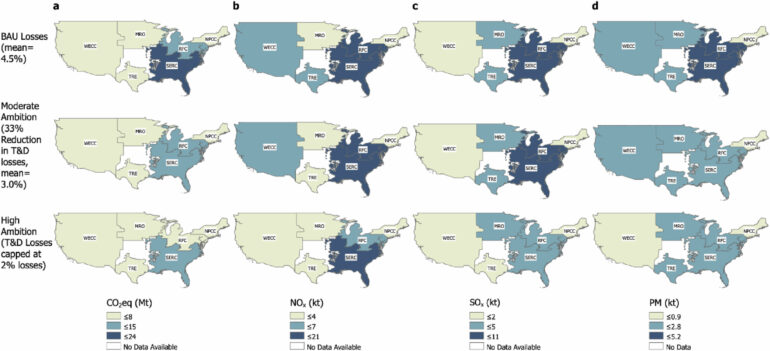Investment in electrical transmission and distribution (T&D) systems could significantly reduce air pollution, according to a study led Lauren Janicke, an undergraduate in civil and environmental engineering (CEE), and Destenie Nock, assistant professor of CEE and engineering and public policy.
Publishing their work in the journal Energy, the researchers measured the air pollution generated through inefficiencies in T&D networks, examined opportunities for reducing emissions through regulation at the multinational and subnational scales, and compared the cost of these potential emissions reductions to the cost of investment in renewable energy.
Janicke, Nock and their co-authors noted that, “Globally, 10.2 million premature annual deaths can be attributed to fossil fuel generation and associated PM2.5 emissions (fine inhalable particles less than 2.5 millionths of a meter in size), a large part of which comes from the electricity sector.”
When there are inefficiencies in the electrical system, more energy must be produced to compensate, resulting in excess emissions from what is termed “compensatory generation.” There are well-explored opportunities for reducing emissions from the way electricity is consumed and generated; however, comparatively little research exists on the potential for reducing air pollution incurred in the delivery of electricity from the generator to the consumer.
By comparing the electricity generated in a given country to the electricity delivered to end users, Janicke and Nock quantified the percentage of emissions resulting from compensatory generation in 142 countries. They found great variation in these, ranging from as low 2% of total generation lost in Singapore, to as high as 60% of total generation in Haiti, and reaching 5% in the U.S. This has an especially strong impact on air pollution for countries reliant on carbon-intensive energy sources. On a global scale, around 2100 Terawatt hours of compensatory generation is required due to these T&D losses.
In analyzing several scenarios, the team found that improving T&D efficiency between 5% and 33% would decrease global median emissions by as much as 40%. The efficacy of emissions reductions within different scenarios varies by pollutant type, and the type of generation prevalent, particularly coal or oil, also correlates with opportunities for emission reductions due to compensatory generation.
In the U.S. there are multiple subnational regulatory bodies, the most prominent being the North American Electric Reliability Corporation (NERC), which works under federal oversight to develop and enforce reliability rules for bulk power electric transmission systems. The different regions within NERC present different energy profiles, meaning different opportunities for reducing T&D losses.
Overall, the high ambition scenario for regulation (5% cap on losses) could cut compensatory generation on average by about 60%—about 3% of total U.S. power generation. The source from which states generate their energy again influences their potential for reductions in emissions through increased T&D efficiency. State policy also plays a major role, with states like North Dakota (heavily coal-dependent) and Texas (natural-gas dependent) having opportunities at the state level that could significantly decrease emissions from compensatory generation.
“It is important to recognize that while improving T&D losses will not completely compensate for relying on fossil fuels, it can reduce current emissions as we are transitioning, and reduce the total amount of renewable generation we will need to build,” said Nock.
Regarding T&D losses themselves, they distinguished between technical losses, resulting from infrastructure inefficiencies, and nontechnical losses, resulting from theft or error. Janicke and Nock noted that technical losses could be eliminated by replacing older T&D infrastructure with newer, high-voltage lines. Likewise, nontechnical losses could best be cut down by reducing electricity theft, deploying smart meters, and enforcing greater accountability in bill payment.
In a cost comparison per ton of carbon dioxide (CO2) abated, they found that smart meters in the U.S. have a median abatement cost of $1,100 per ton of CO2, compared to $700 per ton for wind turbines, and $1,280 per ton for solar plants. However, cost estimates for mass deployment of smart meters still need to be performed, and renewable energy is dependent on weather conditions.
Janicke and Nock estimate that in a moderate ambition scenario for the U.S. with a cap of 33% current T&D losses, wind turbines would be most cost-effective; however, in the high ambition scenario capped at 5%, smart meters become more cost-effective. Smart meters may also have a greater impact in other regions of the world where nontechnical losses are higher, in combination with automated billing.
“We note that countries are using a combination of approaches (smart meters, wind and solar deployment) as part of their decarbonization strategies,” the team concluded. “Smart meters might be cheaper in some cases, and the right combination of smart meters, wind, and solar should be based on spatially resolved analysis. While renewable energy has other benefits beyond reducing carbon emissions, even in a high renewable future, smart meters will be beneficial because they will reduce the electricity demand, leading to fewer investment needs in generation capacity.”
More information:
Lauren Janicke et al, Air pollution co-benefits from strengthening electric transmission and distribution systems, Energy (2023). DOI: 10.1016/j.energy.2023.126735
Provided by
Carnegie Mellon University
Citation:
Increasing transmission efficiency would cut air pollution, say researchers (2023, February 27)
